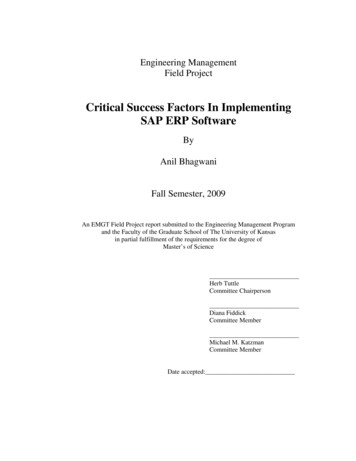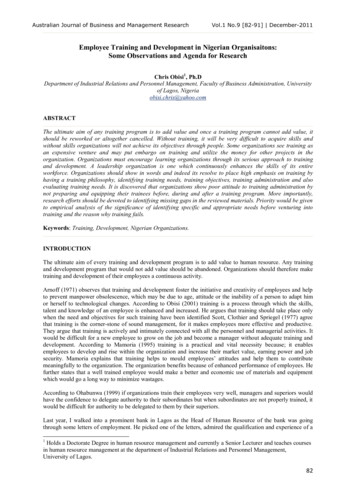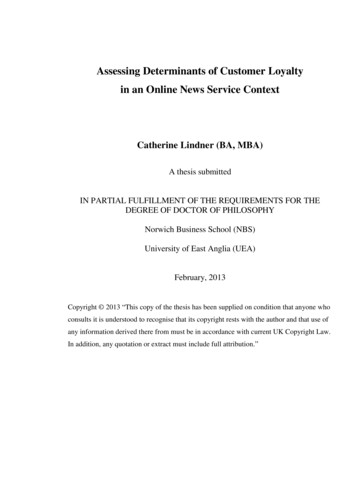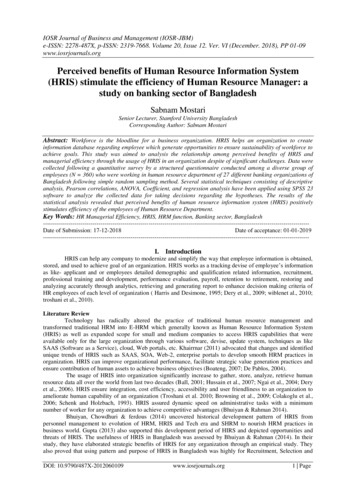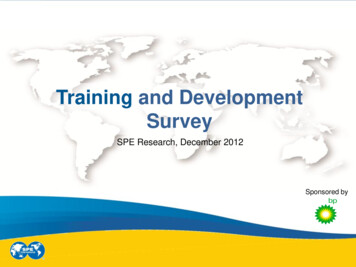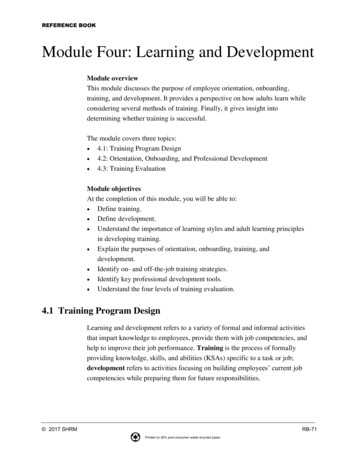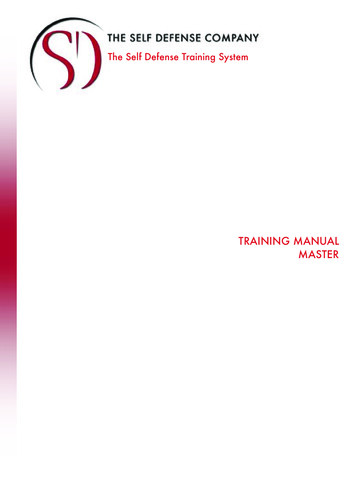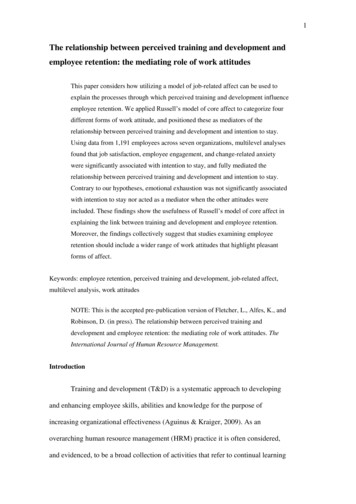
Transcription
1The relationship between perceived training and development andemployee retention: the mediating role of work attitudesThis paper considers how utilizing a model of job-related affect can be used toexplain the processes through which perceived training and development influenceemployee retention. We applied Russell’s model of core affect to categorize fourdifferent forms of work attitude, and positioned these as mediators of therelationship between perceived training and development and intention to stay.Using data from 1,191 employees across seven organizations, multilevel analysesfound that job satisfaction, employee engagement, and change-related anxietywere significantly associated with intention to stay, and fully mediated therelationship between perceived training and development and intention to stay.Contrary to our hypotheses, emotional exhaustion was not significantly associatedwith intention to stay nor acted as a mediator when the other attitudes wereincluded. These findings show the usefulness of Russell’s model of core affect inexplaining the link between training and development and employee retention.Moreover, the findings collectively suggest that studies examining employeeretention should include a wider range of work attitudes that highlight pleasantforms of affect.Keywords: employee retention, perceived training and development, job-related affect,multilevel analysis, work attitudesNOTE: This is the accepted pre-publication version of Fletcher, L., Alfes, K., andRobinson, D. (in press). The relationship between perceived training anddevelopment and employee retention: the mediating role of work attitudes. TheInternational Journal of Human Resource Management.IntroductionTraining and development (T&D) is a systematic approach to developingand enhancing employee skills, abilities and knowledge for the purpose ofincreasing organizational effectiveness (Aguinus & Kraiger, 2009). As anoverarching human resource management (HRM) practice it is often considered,and evidenced, to be a broad collection of activities that refer to continual learning
2and development of general job- and career-related skills (e.g. Boon, den Hartog,Boselie, & Paauwe, 2011). Previous research demonstrates that perceived T&D isassociated with higher levels of retention (Aguinus & Kraiger, 2009), as T&Dstrengthens the social exchange relationship between the employee and theiremployer (Dysvik & Kuvaas, 2008).More recently, researchers have become interested in understanding the exactmechanisms that underlie this relationship (e.g. Koster, de Grip, & Fourage, 2011). Forexample, Koster et al. (2011) demonstrated that job satisfaction partially mediated therelationship between perceived support in employee development and intention to quit.In contrast, Dysvik and Kuvaas (2008) showed that intrinsic motivation partiallymediated the relationship between perceived T&D and turnover intentions, and Newman,Thanacoody, and Hui (2011) found that perceived availability of training was relatedindirectly to turnover intentions via affective and continuance commitment.While these studies have enhanced our understanding of how T&D is related toretention, they identify a broad range of attitudes, where each, individually, only partiallymediates this relationship. This indicates that the mediation space has not been fullyexplored theoretically or empirically. Hence, to date, there is no conclusive evidence asto why T&D relates to intentions to stay. Exploring mediators individually is problematicfor a range of reasons. Firstly, it encourages researchers to add potential mediators intothe literature with little consideration of how they are differentiated from others.Therefore, there may be a number that overlap conceptually, which makes it difficult toclarify the exact processes through which perceived T&D influences employee retention.Secondly, examining mediators in isolation limits the degree to which we can be surethat the mediator is practically important. Some may overpower others, or have specificeffects, and so it is crucial to include a comprehensive range of potential mediators
3within analyses in order to untangle the mechanism through which perceived T&Dinfluences retention. Thirdly, work attitudes and levels of retention may varysignificantly across different settings, particularly between public and private sectors(Abualrub, Omari, & Al-Zaru, 2009; Trinchero, Borgonovi, & Farr-Wharton, 2014).Therefore, there is a need to examine the links between perceived T&D, work attitudes,and employee retention across a range of organizations.The present study attempts to address these issues by drawing from and testing amodel of job-related affect that we propose mediates the relationship between perceivedT&D and intention to stay. More specifically, we use the conceptual and neurologicalunderpinnings of Russell’s (1980) model to help organize and identify a range ofattitudes that each connotes a specific aspect of positive or negative work-relatedwellbeing that connects T&D with employee retention, based on their level of arousaland pleasure. We seek to contribute to the literature on T&D in at least two ways.First, we introduce Russell’s (1980) model of core affect as a suitable frameworkfor identifying a ‘full’ range of work attitudes that are associated with both T&D andemployee retention. Although a multitude of work attitudes have been identified withinthe literature, there is no overarching framework that organizes them according to theiraffective properties. We propose that work attitudes can be categorized into four groupsbased on the quadrants of Russell's (1980) model. More specifically, we identify that thework attitudes of job satisfaction, emotional exhaustion, employee engagement andchange-related anxiety each occupy a specific quadrant, and are each related to retention.Second, we apply this framework to better understand the cognitive-affectivepathways through which perceived T&D impacts on intentions to stay. As individualsappraise events cognitively as well as emotionally (Colquitt et al., 2013), an integratedperspective that considers both cognition and affect is needed in order to fully understand
4why organizational factors, such as T&D relate to important employee outcomes, such asretention. The present paper draws on Russell’s (1980) affect-based model to suggest thatemployees will cognitively evaluate the degree to which they have received opportunitiesfor T&D, and will emotionally respond to having received T&D within theirorganization. Clarifying these pathways will help practitioners facilitate employeeretention, and will strengthen the business case for investing in training and development,particularly during periods of economic instability and organizational change. We alsotest our model across different organizations and sectors, thus increasing thegeneralizability of the findings.In sum, this study builds and tests a mediation model that links perceived T&D tointention to stay (as represented by Figure 1). In doing so, we aim to bring clarity toHRM research by clearing up the mediation space that links perceptions of HRMpractices with employee outcomes. We test our hypotheses on a multilevel datasetrepresenting 1,191 employees from seven organizations in the United Kingdom.INSERT FIGURE 1 HEREThe importance of perceived training and developmentT&D gives the employee opportunities to acquire and develop valuable resourcesin the form of skills, abilities and knowledge (Koster et al., 2011). Thus, it represents acrucial way to increase employee retention as it elicits strong obligations, within theemployee, to repay the organization for investing in their personal and careerdevelopment (Lee & Bruvold, 2003). However, there is a need to differentiate betweenlevels of analysis when examining the impact of HRM practices on employee outcomes,such as employee retention (Wright & Boswell, 2002; Wright & Nishii, 2007). Intendedpractices, as developed by the HRM department, capture an organization’s strategicHRM intentions. They are typically interpreted by various line managers, who implement
5these HRM practices in their day to day work with employees. Employees perceive andreact to these HRM practices in different ways depending on a range of factors such aspast experiences and attributions that they each make about the reasons why managementhave enacted them (Nishii, Lepak, & Schneider, 2008). The present study focuses onperceived T&D as it is these individual-level perceptions of an HRM practice that havethe most significant and influential effect on employee attitudes and behaviours (Guest,2002).Russell's model of core affect and its application to work attitudesThe differentiation between work attitudes has been debated for many years, withevidence, on one hand, indicating that some attitudes may be better conceptualized as aunified general factor (e.g. Harrison, Newman, & Roth, 2006) and evidence, on the other,suggesting that although many work attitudes are related to one another, they are separateand distinct constructs with different foci and effects (e.g. Tett & Meyer, 1993).Although this debate is still ongoing, the majority of research on work attitudes treatsthem as independent and distinct constructs. Therefore, being able to organize workattitudes in a systematic way is important because it not only ensures differentiation anddistinction between them, but also integrates them into a unified framework. In otherwords, it enables greater precision of prediction and enhances our understanding of thedifferent properties and mechanisms of a range of attitudes.Inherent in definitions of many work attitudes, such as job satisfaction, is thepositioning of affect as a fundamental property (Warr, Bindl, Parker, & Inceoglu, 2014).Affects are "primitive, universal, and simple, irreducible on the mental plane" (Russell,2003, p.148) and refer to a wide range of emotions, moods and feelings that can beorganized along two dimensions: pleasure - signifying pleasant affect at one end andunpleasant affect at the other (i.e. affective valence); and arousal – representing activated
6affect at one end and deactivated affect at the other (i.e. readiness for action/expendingenergy). Russell (1980) combined these two dimensions to form a model of 'core affect' neurophysiological states that are conscious and non-reflective. The model identifies fourmain forms of core affect, specified by the quadrants made by the intersecting pleasure(horizontal plane) and arousal (vertical plane) dimensions. The pleasant, activatedquadrant refers to feelings such as enthusiasm and excitement; the pleasant, deactivatedquadrant signifies feelings of contentment and calmness; the unpleasant, deactivateddenotes feelings of dejection and boredom; and the unpleasant, activated indicatesfeelings of tension and anxiety.Researchers have increasingly used this model to categorize affect basedresponses (Bakker & Oerlemans, 2010; Bakker, Albrecht, & Leiter, 2011; Schaufeli,2014; Warr et al., 2014), and argued that although work attitudes are related to oneanother, they are distinct enough to represent specific forms of attitude that can bedifferentiated by their affective properties. In the present paper we follow thisargumentation and take Russell's (1980) model as a starting point to understand theattitudinal antecedents of intention to stay. We focus on measuring attitudes rather thanaffect directly because an attitude is an evaluative response to one's environment directedat a known object, in this case one's job, whereas affect is a non-evaluative response thatis not derived from a specific stimulus nor is it directed towards a known object (cf.Eagly & Chaiken, 2007; Russell, 2003). Therefore, attitudes are more likely to directlyinfluence employee outcomes as they have a specific evaluative function that can driveaction and behaviour. In fact, HRM scholars have argued that employees react to HRMpractices attitudinally, and that these attitudinal reactions drive subsequent behaviour,such as the decision to stay or leave an organization (Guest, 2002; Wright & Nishii,2007). In line with Bakker et al. (2011) and Schaufeli (2014) we position emotional
7exhaustion within the unpleasant, deactivated quadrant; job satisfaction within thepleasant, deactivated quadrant; and employee engagement within the pleasant, activatedquadrant. Furthermore, we argue that the affective underpinnings of change-relatedanxiety align with those of the unpleasant, activated quadrant.Emotional exhaustion is a core facet of burnout and refers to being drained anddepleted of emotional energy. It reflects a passive withdrawal from the job that reducesthe employee’s capabilities of maintaining a sense of emotional involvement in theirwork (Maslach, Schaufeli, & Leiter, 2001). Individuals who experience high levels ofemotional exhaustion find it difficult to psychologically connect with their environment(Alarcon, 2011). As a result, these individuals lack the motivation and desire to maintaintheir involvement in their work activities, which results in lower intentions to stay withthe current organization (Maslach et al., 2001). A meta-analysis by Alarcon (2011)demonstrates that individuals who experience high levels of emotional exhaustion areless inclined to stay than those who experience low levels of emotional exhaustion, andsome studies have shown that although levels of emotional exhaustion vary acrossdifferent organizations and sectors, emotional exhaustion negatively influencesemployees’ attitudes towards their employment (e.g. Vigoda-Gadot & Kapun, 2005).Hypothesis 1: Emotional exhaustion will be negatively associated with intention to stay.Job satisfaction is defined as a positive evaluation of one’s job that results fromperceiving that one’s actual job outcomes are commensurate with the outcomes onedesires (Schleicher, Hansen, & Fox, 2010). It is a positive state that elicits moderate-tolow arousal because it relates to the individual feeling that their job provides anacceptable level of what is desired (Locke, 1976). Job satisfaction has long been viewedas a causal factor that promotes intentions to stay with the organization because it is apleasant psychological state; the individual feels content with the work that they do and
8the job role they perform (Locke, 1976). Therefore, satisfied employees are motivated tosustain these positive experiences by continuing to participate in social exchangesbetween themselves and the organization, which further reinforces their intentions to staywith the organization (Koster et al., 2011). Indeed, meta-analytic evidence hasdemonstrated that those who are satisfied at work are more likely to want to stay ratherthan leave (Griffeth, Hom, & Gaertner, 2000), and studies have shown that employeesfrom different organisations and sectors vary in their levels of job satisfaction, yet therelationship between job satisfaction and intent to stay is shown to be positive (e.g.,Abulalrub et al., 2009)Hypothesis 2: Job satisfaction will be positively associated with intention to stay.Employee engagement can be defined as "a positive attitude held by theemployee toward the organisation and its values. An engaged employee is aware ofbusiness context, and works with employees to improve performance" (Robinson,Perryman, & Hayday, 2004, p.4, see also Jenkins & Delbridge, 2013). Employeeengagement is a positive and activated attitude because it reflects a sense of high arousal,energy and involvement with one's work (Parker & Griffin, 2011). Engaged employeeswill feel strongly affiliated to the organization because they perceive their work to bemeaningful and fulfilling (Saks, 2006). Therefore, employees who are highly engagedwill be more likely to stay with the organization than those who exhibit low levels ofengagement because they have a strong personal connection with the organization andtheir work role. This connection is a powerful signal to the employee that there is amutually beneficial relationship between themselves and their employer, which should bemaintained by staying with the organization (Saks, 2006). A recent evidence synthesisfound support for this proposition (Bailey, Madden, Alfes, & Fletcher, 2015), and whilethere is some evidence that engagement varies across different organizations and sectors,
9engaged employees across all sectors are more likely to stay with their employer (e.g.,Trinchero et al., 2014)Hypothesis 3: Employee engagement will be positively associated with intention to stay.Lastly, change-related anxiety is an emotional state that refers to feelingoverwhelmed by changes occurring within the work environment, and may reflect similarpsychological responses as work intensity (cf. Berneth, Walker, & Harris, 2011; Burke,Singh, & Fiksenbaum, 2010). It can be seen as a specific form of job anxiety because theindividual feels uncertainty about the nature and impact of impeding changes, as well asa constant drive to work hard in order to adapt to such changes. These experiences causeanxiety and worry and so such feelings reflect "an emotional state of perceivedapprehension and increased arousal" (Jensen, Patel, & Messersmith, 2013, p.1703).Change-related anxiety, rather than job anxiety, was focused on in the present studybecause the work environments that respondents were working in at the time of the studywere highly demanding, unstable contexts due to the UK economic recession. Many ofthe organizations in the sample, particularly the public and voluntary organizations, hadexperienced significant reductions in funding or revenue as a result of the recession.They were under pressure to implement significant cost-cutting initiatives, such asrestructuring, streamlining services, and redundancies, which had increased feelings ofanxiety due to heightened job insecurity and uncertainty of the future. Many changesoccurring within the organizations during the time of data collection had impacted, tovarying degrees, on employees’ feelings of anxiety and stress. For instance, two of thevoluntary organizations were significantly changing their HRM practices to develop adifferent culture, the public sector organizations were either planning or implementingsignificant structural changes, and the private organization was altering employee termsand conditions as well as day-to-day working practices. When employees experience
10such a negative, yet arousing emotional state, they are unable to replenish the energiesneeded to sustain healthy functioning and so they must withdraw themselves in order toconserve their resources (Hobfoll, 1989). An initial action that an employee can take toconserve resources is to cognitively withdraw from their organization, i.e. reducedintention to stay. Indeed, studies have found that in organizations undergoing significantchange employees who do not cope well with the changes are more likely to leave theorganization (Cunningham, 2006), and that although work-related stress and anxietyvaries across different organizations and sectors, such perceived stress negativelyimpacts on employee attitudes towards their employment (e.g., George & Zakkariya,2015; Vigoda-Godot & Kapun, 2005)Hypothesis 4: Change-related anxiety will be negatively associated with intention tostay.In sum, we propose that the work attitudes of job satisfaction, emotionalexhaustion, employee engagement and change-related anxiety reflect different forms ofjob-related affect, which are each related to intentions to stay with the organization.Thus, they represent distinct, yet related conceptual spaces (see Figure 2), that help tocategorize and explain the mediation pathways of the relationship between T&D andintent to stay (see Figure 1). In the following sections we derive our hypothesesregarding the mediation pathways.INSERT FIGURE 2 HEREThe mediating role of work attitudes in the relationship between perceived trainingand development and intentions to stayThe relationship between T&D and intentions to stay is not direct, but rather it ismediated by the attitudes that employees hold of their work and the working environment
11(Guest, 2002). Indeed, prior studies have provided evidence that a range of individualwork attitudes have a mediating role in the relationship between perceived training anddevelopment and intentions to stay or leave the organization (e.g. Dysvik & Kuvaas,2008; Koster et al., 2011; Newman et al., 2011).In this paper, we have applied Russell’s (1980) model of core affect to organizepotential mediating attitudes according to their affective properties. Recently, Bakker andOerlemans (2011) argue that Russell’s (1980) model can be used to distinguish betweentwo main types and effects of work-related subjective wellbeing: positive forms andeffects that can be high (e.g. engagement) or low (e.g. job satisfaction) in activation, andnegative forms and effects that can also be high (e.g. anxiety) and low (e.g. emotionalexhaustion) in activation. Using this distinction, we firstly focus on the negativewellbeing pathway and propose that perceived T&D acts to promote employee retentionby preventing negative forms of wellbeing. This is because training provides employeeswith psychological skills, such as resilience, which helps them to cope with changeswithin their environment and, as a result, leaves them less emotionally exhausted andanxious (Baruch & Lambert, 2007; Robertson, Cooper, Sarkar, & Curran, 2015).Reducing emotional exhaustion and change-related anxiety, in turn, will increaseretention because feeling less exhausted and anxious will make withdrawing from theorganization less likely (Warr et al., 2014), and make one's commitment to theorganization stronger (Bernerth et al., 2011).Secondly, we follow the positive wellbeing effects according to Russell’sframework and argue that perceived T&D acts to facilitate employee retention bydeveloping positive forms of wellbeing. This is because perceptions of T&D signal to theemployee that the organization has fulfilled their obligation to provide adequateresources and skills needed to perform activities that can lead to the fulfilment of
12extrinsic needs (Lee & Bruvold, 2003). As a result, the individual is more satisfied withtheir job, and in turn is happy to stay with the organization. Moreover, the employee willfeel more engaged because perceived opportunities for training facilitates the fulfilmentof intrinsic psychological needs, such as meaningfulness, safety and availability, whichelicits pleasant, activated feelings, such as enthusiasm, that energize the employee tobecome more involved in their work (Fletcher, 2016a; 2016b). This will, and as such,strengthen their intention to stay with the organization as they want to continue to investthemselves in their work (Parker & Griffin, 2011).Hypothesis 5a: Emotional exhaustion will mediate the relationship between perceivedT&D and intention to stay.Hypothesis 5b: Change-related anxiety will mediate the relationship between perceivedT&D and intention to stay.Hypothesis 5c: Job satisfaction will mediate the relationship between perceived T&D andintention to stay.Hypothesis 5d: Employee engagement will mediate the relationship between perceivedT&D and intention to stay.Finally, we propose that the work attitudes of job satisfaction, employeeengagement, emotional exhaustion, and change-related anxiety, together, will fullymediate the relationship between perceived T&D and intention to stay. This is becausethe affective states associated with Russell's four quadrants have been found to exertdifferential effects on employee outcomes (Warr et al., 2014). We argue that as eachwork attitude reflects a specific cognitive-affective response, they will operate together toinfluence broader employee behaviour.
13Hypothesis 6: The work attitudes of emotional exhaustion, change-related anxiety, jobsatisfaction, and employee engagement will, together, fully mediate therelationship between perceived T&D and intention to stay.MethodSample CharacteristicsA total of 1,809 employees from seven organizations based in the UK receivedthe IES employee engagement survey between 2008 and 2012. The data was collectedvia a number of commissioned research projects on the employment relationship that IESundertook within this timeframe. Each organizational sample had data collected at onepoint in time within the five year timeframe, and approximately one to two samples werecollected per year. This research design is in line with other research studies that havefocused on gaining a large dataset from multiple organizations (Harter, Schmidt, &Hayes, 2002; Langford, 2009; MacCormick & Parker, 2010). We decided to use the fullsample rather than focus on the most recent sub-sample in order to gain a large samplesize and to achieve maximum power. Responses were received from 1,191 employees,constituting a 65.8% response rate. 52% of respondents were female; the median agecategory was 30-39 years. Responses ranged from 26 to 399 employees for eachorganization (median 88 employees). A summary of the organizations is given in table1, where it shows that there was substantial variation between the organizations withregard to workforce composition and the diversity of sectors being represented.INSERT TABLE 1 HEREMeasuresAs the present study aims to capture an individual’s work-related attitudes andtheir impact on the individual’s intent to stay, self-report measures were used becausethey are a reliable approach to understand how employees feel about their work situationand their behavioural intentions. All measures that follow, unless otherwise stated, use a
145-point Likert scale (strongly agree, agree, neither agree/disagree, disagree, stronglydisagree) and were taken from the IES employee engagement survey (Robinson, Hooker,& Hayday, 2007).The IES employee engagement survey was initially designed in 2004 (Robinsonet al., 2004) and was consolidated in 2007 (Robinson et al., 2007). It is an evidencebased employee attitudes questionnaire that is grounded from the literature on theemployment relationship. It is used primarily by organizations who want to understandthe perceptions and attitudes of their employees so that they can better design theirinternal HRM strategies and initiatives. Therefore, it provides an opportunity to gain datafrom a wide range of organizations. The questionnaire is usually administered as a oneoff or annually, and has been used by over 20 organizations since 2004 (although only 7have agreed for their data to be used for research purposes). To assess the validity of theIES questionnaire, we collected additional data to compare the psychometric propertiesof the IES scales to alternative published scales1. All items for the measures in thepresent study are included in Appendix 1.Perceived T&DA three-item perceived T&D scale was taken from the IES employee engagementsurvey (Robinson et al., 2007). An example item is ‘I am encouraged to develop newskills’. Inter-item reliability was α .82.Job Satisfaction:A three-item job satisfaction scale was taken from the IES employee engagementsurvey (Robinson et al., 2007). An example item is ‘Overall, I am satisfied with my job’.1This results from these additional analyses are available from the first author upon request.
15Inter-item reliability was α .91.Emotional Exhaustion:A three-item emotional exhaustion scale was taken from the IES employeeengagement survey (Robinson et al., 2007). An example item is 'I have felt emotionallydrained by my work'. Inter-item reliability was α .91.Employee Engagement:The IES 12-item measure of employee engagement (Robinson et al., 2007) wasused. The measure covers the following content: a) pride in the organization (e.g. ‘Ispeak highly of this organization to my friends’); b) belief that the organization providesgood products/services and enables the employee to perform well (e.g. ‘I would be happyto recommend this organization’s products/services to my friends and family’); c) awillingness to behave altruistically and go beyond what is required (e.g. ‘I try to helpothers in this organization whenever I can’); and d) an understanding of the ‘biggerpicture’ (e.g. ‘I find that my values and the organization’s are very similar’). Inter-itemreliability was α .85.Change-related AnxietyA two-item change-related anxiety scale was taken from the IES employeeengagement survey (Robinson et al., 2007). An example item is 'I sometimes feeloverwhelmed by the pace of change here'. Inter-item reliability was α .88.Intention to stay:A single item measured the employee’s intentions to stay at their currentorganization: ‘Which of the following statements most reflect your current intentions? 1Plan to leave as soon as possible, 2- Likely to leave within the next year, 3- Likely to stayfor at least another year, 4- Plan to stay for the foreseeable future’. Single item scales
16measuring turnover intentions (positive or negative valence) have been used in a numberof academic studies (e.g. Ng & Butts, 2009), and, in general, single item scales have beenfound to have good reliability and face validity (Bergkvist & Rossiter, 2007).Control variables:Gender (0 male, 1 female), age (1 30 years, 2 30-39 years, 3 40-49 years,4 50 years), tenure (1 1 year, 2 1- 3years, 3 4- 7 years, 4 7 years) andmanagement responsibility (0 no, 1 yes) were included as control variables. Thesevariables are controlled for because studies that examine perceived HRM practices oremployee retention have demonstrated that they are associated with such intentions andperceptions (e.g. Dysvik & Kuvaas, 2008; Koster et al., 2011).Data AnalysisDue to the data being self-report and collected at one point in time, proceduraland statistical remedies were used to ensure the distinctiveness of the constructs andaddress the potential i
The relationship between perceived training and development and employee retention: the mediating role of work attitudes. The International Journal of Human Resource Management. Introduction Training and development (T&D) is a systematic approach to developing and enhancing employee
